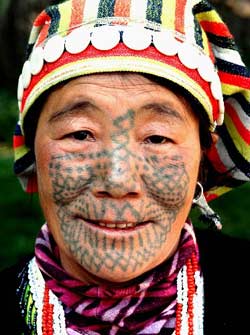|
52. Chinese Nationalities (Derung Minority)(Dulong) - Page 2 -- Minorities by Descending Populations |
|

|
During the Tang Dynasty (618-907), the places where the Derungs lived were under the jurisdiction of the Nanzhao and Dali principalities. From the Yuan Dynasty (1271-1368) to the end of the Qing Dynasty (1644-1911), the Derungs were ruled by court-appointed Naxi headmen. In modern times, the ethnic minority distinguished itself by repulsing a British military expedition in 1913. Before the founding of the People's Republic of China in 1949, Derung society maintained many vestiges of the primitive commune system. There were 15 patriarchal clans called "nile." Each nile consisted of several family communes, and each commune occupied a separate territory marked off by boundaries such as streams and mountain ridges. The clan was further divided into "ke'eng," or villages, where people dwelt in common long houses. The ke'eng members pursued collective farming on common land and held their hunting, fishing and gathering grounds in common. However, in modern times this system was slowly giving way to ownership of the means of production by blood-related families. Following financial difficulties due to illness or debt as a result of the imposition of taxes, land sales gradually led to the emergence of oppressive landlords. And rich households used to make seasonal workers and destitute children work for them. The Derung people (mainly young women) have the custom of tattooing the face, to differentiate different clans. This custom has basically disappeared after the liberation in 1949. Return to Derung Page 1 |
| Derung Lady | |
|
The Derung people, male and female, wear their hair down to their eyebrows in front and down to their shoulders behind. Both sexes used to wrap themselves in a covering of striped linen fastened with straw ropes or bamboo needles. The poorer ones would often have no other clothing but a skirt of leaves. The Derungs are animists and make sacrificial offerings to appease evil spirits. Shamans, and sometimes the kashan, performed such rites. The Derung New Year falls in December of the lunar calendar. The exact date is not fixed, nor is the duration of the celebration, which lasts as long as the food does. Cattle are slaughtered as an offering to Heaven, and the Derungs dance around the carcasses. |
|